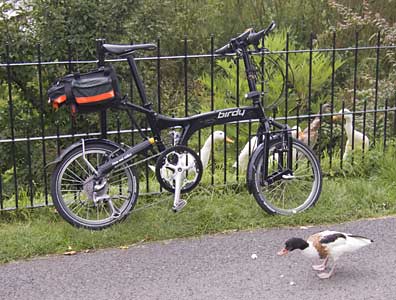
First published June 2007
Updates and comments from other owners added July 2007

The Birdy first appeared in the mid 1990's, at a time when the choice of folders was far less than it is today, and folders were not nearly as popular as they are now. Due at least in part to the scarcity of folders, but also because of its features and striking appearance, this new machine created a great deal of interest. The bike was designed by the German company Riese & Muller (r&m) - it was their first product; they now have a range of machines available, although the Birdy is apparently now the only folder, as the diminutive Frog no longer seems listed. The frame is made in Taiwan, but I believe that nowadays the final assembly of the complete bike is done in Germany. Possibly as a result of a deal covering the original costs of tooling for manufacture, the bike is sometimes found in markets outside Europe and North America under other names.
The Birdy is available in a number of model specifications, which vary mainly in the type of gears fitted. The model names were originally colours - Red, Green, Blue etc - and each model was only available in its named colour. The colours and precise specifications varied from one country to another, and what follows relates to the situation here in the UK. The Red used a simple 7-speed derailleur which later became an 8-speed, the Green varied in specification at different times (including briefly a belt drive) but latterly was a 7 or 8-speed hub, the Elox (later Back) was a higher-specification derailleur, the White used the Capreo derailleur system (specifically intended for small-wheelers), the Blue used a combined 3-speed hub and derailleur gear system ('Dual Drive') and the Grey used the 14-speed Rohloff hub gear.
Over the years the design has evolved somewhat, with some strengthening of parts of the bike, improvements to allow more and better luggage carrying options etc.
All Birdys have had essentially the same suspension design, with an anti-dive system with a spring and elastomer at the front, (the suspension system also playing a role in how the front wheel is folded when the bike is folded), and a rear triangle which pivots near the bottom bracket and presses against an elastomer at the top to provide rear suspension - different hardnesses of elastomer are available to suit different weights and riding styles of the rider.
For 2006 r&m announced a new frame design, (see the next section) and revised the model specifications somewhat, so that every model was available in every colour, with the exception of the Red, which retained the old frame, name and single colour. Apart from the Red, the other models are now the Touring (old Blue, 3x8 gears), City (old Green, 8-speed hub gear), Speed (old Black/Elox/Capreo, with lighter and higher quality 9-speed Capreo derailleur etc), Rohloff (the old Grey), and a new Light model (listed on r&m site in German, but not English, and possibly in effect the Red with the new frame?).
At the time it was introduced the Birdy looked particularly appealing to those seeking a folder which was both a compact train-assisted commuting machine and which could also be used for more serious rides - touring, fast day rides etc - as well. Naturally this has to involve some compromises, but the Birdy seemed to balance these compromises, whereas many other folders concentrated primarily on one type of use. That is still true to some extent today, although there are now other folders which would aspire to achieve the same thing. So if we compare the Birdy in very general terms with a Brompton (not necessarily a particularly sensible comparison in that they are not aimed at exactly the same customer), the Brompton is more compact when folded, has (or at least had) better luggage options for commuting, and is cheaper in most cases, while the Birdy offers more gears and front suspension, amongst other things. Although nominally lighter, the Birdy has little if any advantage over the Brompton by the time mudguards, racks, a pump etc are included. Comparing the Birdy with machines like the Bike Fridays (prior to the new Tickit) and the Airnimal (Chameleon and Joey), the Birdy is a far simpler and more compact fold, but does feel a bit lethargic on the road compared to those other machines.
I've owned 2 earlier Reds, the first being a 7-speed which I upgraded to a 9-speed, with Shimano Megarange 11-34 cassette, and the second was an 8-speed, which I did not alter. Reports have been published in the past on this web site on both machines. The first one was kept for about 2 years, but I was never very happy with the tyres available, which made the bike feel quite sluggish, and at the time the luggage options were really not good at all. It also rattled terribly, and although with some work I was able to reduce this, there were still incurable irritiating noises (cables on the main frame were a major source). After a break of a couple of years I bought another Red, which by this time was an 8-speed model, with forks to allow mounting of front panniers, some strengthening of the frame, slightly improved tyre options etc. Again, I kept this machine for a couple of years, and then sold it as it still left me feeling slightly frustrated - I expected more from it. Here it is very important to point out that I have several (a lot!) of folders, so that in many respects for me the versatility of the Birdy counted against it - I would all too often be thinking, depending on the circumstances, either that I should be using a Brompton, because of its smaller folded size and more convenient quick-release luggage, or I should be using a Bike Friday, because it would be more enjoyable on a longer, fast ride. Rarely would I find on a single outing that I really needed both the strengths of the Brompton and of the Bike Friday, so I would choose the more suitable machine, and the Birdy would not get used. If you don't have a choice of bikes, the mixture of strengths of the Birdy looks far more attractive.
So late in 2006, with some outings coming up which would involve using trains quite a bit, and riding moderate distances with a substantial amount of luggage, the revised 2006 Birdy came to the top of my list, and I bought one. This time, bearing in mind the intention to carry quite a bit of luggage in hilly terrain, I decided to go for the Touring model - an 8-speed just would not have enough gears (especially low ones) for me, and the Rohloff model, though attractive in some respects, was just far too expensive. After planning to buy an exciting-looking orange machine, when I got to the shop I decided to go for the much more restrained black version!
This report was first published in June 2007. Following some comments from other Birdy owners, it was updated in July 2007 to include their input, plus the expereince gained of the bike since the original publication of the report. The comments of other owners can be found in the new section 12, and ammendments in the original report have been indicated by the use of italics.
The original Birdy frame consisted of circular or oval tubes for the main frame members, with box-section elements for parts of the front and rear forks. Both forks have seen some design changes over the years, but these would not be obvious to non-owners, and were primarily associated with strengthening certain parts and providing mountings for carriers. For 2006 a new main frame and rear forks were introduced, although the front forks do not appear to have changed much if at all. The new frame is much more curved in appearance, and is made in two halves which are welded together. The overall effect is probably more stylish, but personally I find the welded type of frame construction (increasingly common on bikes of all kinds) looks rather agricultural, even when done well, as it is on the Birdy. It is claimed that there is a small saving in weight and an increase in stiffness with the new frame, though I can't say that either is very obvious in practice. The new frame is used for all the models except the Red. The main changes which the owner of an early Birdy would notice are the mounts on the front forks to take a pannier rack (these first appeared some years ago), mounts to support the back of the mudguard properly, mounts for the optional folding rear carrier, and cables enclosed within the frame tubes.
The frame is all aluminium, and finished throughout in one of the available colours (check with r&m and/or your dealer to find out what is available). The finish (powder coat) is a very smooth and shiny gloss, though rather thin, but if it does get scratched or chipped it will not rust. The standard of manufacture of the frame and the assembly of the bike seem good.
One other area where there has been a change is the hinge for the stem/steerer, which now looks more robust and neater, and has a revised clamping lever.
The most obvious difference between the various models of Birdy lies in the gears, as mentioned earlier. The Touring uses a combination of an 8-speed derailleur and 3-speed hub. In the past this was the Sachs 3x7, which later became the SRAM Dual Drive (3x8), but the current version uses a Shimano Nexave Intego 3x8 system. The 56-tooth chainring combines with a 11-30 cassette to give a range of about 24 to 115 inches. Like all Birdys, this is rather high for my taste - normally the 24 inch bottom gear is low enough, but for touring with luggage in hilly terrain I'd like something lower, especially given a top gear which I would almost never use. Unfortunately it is not as easy to lower the overall gearing as one might expect with most bikes (by fitting a smaller chainring) because of the fittings which retain the chain when the bike is folded. The spacing of the gears is very even, and this type of gear system has the virtue that you can change gear on the hub while the bike is stationary - handy if you have to stop unexpectedly in a high gear, so long as the hub is not already in its lowest gear. I will return to the subject of gearing later (see section 10).
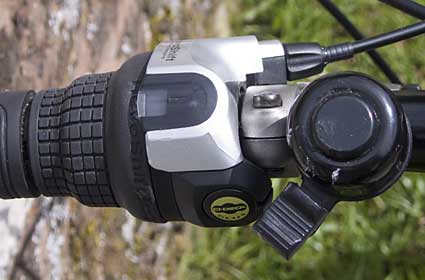 The gear
change is achieved via
twist grips on the bars. The rear
derailleur change works effectively (again I will come back to this),
and so does the hub changer, although the twist grip has a much longer
travel than seems needed, so that at times the indicator on the twist
grip is between
marked gears, and so can't be read. The Shimano hub to cable link is
through a small box on the end of the axle. An allen key is needed to
release it to allow removal of the rear wheel when dealing with
punctures, and it is quite stiff to operate. As is usual with a hub
gear, you need a spanner to release the wheel - no
quick releases, so make sure you have a suitable spanner with you, and
remember most multi-tools won't incorporate such a spanner. Once
the allen screw holding the cable/hub link is slackened, the box lifts
off, and can be put back afterwards without any need for gear adjustment
The gear
change is achieved via
twist grips on the bars. The rear
derailleur change works effectively (again I will come back to this),
and so does the hub changer, although the twist grip has a much longer
travel than seems needed, so that at times the indicator on the twist
grip is between
marked gears, and so can't be read. The Shimano hub to cable link is
through a small box on the end of the axle. An allen key is needed to
release it to allow removal of the rear wheel when dealing with
punctures, and it is quite stiff to operate. As is usual with a hub
gear, you need a spanner to release the wheel - no
quick releases, so make sure you have a suitable spanner with you, and
remember most multi-tools won't incorporate such a spanner. Once
the allen screw holding the cable/hub link is slackened, the box lifts
off, and can be put back afterwards without any need for gear adjustment
Which
gear is the hub in?
Bottom of course - the twist grip has a long travel, but only a small
movement is needed to change gear on the hub, with the result that the
indicator window may show nothing at all when changing into bottom,
unless you make a point of twisting it all the way.
The Touring is fitted with Avid V-brakes and levers. I'd rate them as a bit disappointing (considering they are V-brakes), though quite adequate - they are certainly an improvement over my immediately previous Birdy Red, where the brakes were quite poor, even with a change of blocks. These on the Touring require a fair amount of force, but are quite progressive, and stop the bike quite smoothly, but they lack real 'bite' - at least there is not much risk of locking the back wheel unless on a slippery or loose surface. The levers look and feel good, incorporate an adjustment to take up the slack as the blocks wear, and can be adjusted for reach. Like all V-brakes, when removing/replacing a wheel when the tyre is not fully deflated, you need to detach the one end of the cable fixing at the brakes - just don't forget to re-attach it after putting the wheel back on, or you will have no brakes at all on that wheel.
The Birdy uses the rather unusual 18 inch (355) rim size, and the lack of good quality tyres in this size used to be one of the most serious weaknesses of the machine [some very early adopters actually changed the 18 inch wheels for 16 inch ones, as used on the Brompton, for this reason, and the late Peter Evans successfuly fitted 17 inch Moulton ones - the peculiarities of wheel/tyre specifications mean that there is much less difference between these sizes than their nominal dimension might suggest]. Now there are a number of excellent tyres available in this 355 size, at least for road use. For fast road riding, at the expense of reduced durability and puncture resistance, there is the Schwalbe Stelvio, and as standard the Birdy is fitted with the Schwalbe Marathon Racer. This seems an excellent tyre - good rolling resistance, some tread and moderately wide, so that it is happy on light off-road riding as well as on the road. It is rated at 85psi, and since this does not seem to impinge on rolling resistance, this relatively modest pressure is certainly an advantage if you have to re-inflate it by the roadside after a puncture. The tubes use Presta valves, which is certainly preferable in my view (they seem to hold pressure better than Schraders, it is easier to get the air in, and you don't lose as much air as you detach the pump from the valve). It is advisable to keep a spare tyre in stock and some tubes as well, as you will find it difficult to obtain them in most places (a 349 16 inch tube might do in an emergency I suppose). I believe the Birdy off road knobbly tyre is still available if you want something for more serious off-road riding, but to be honest small wheels of all sizes are not at their best in extreme off-road conditions, and this tyre is reportedly very sluggish for on-road use. I find the Marathon Racers are perfecly happy on canal towpaths, cycle paths, normal forest trails etc, and I've even used the narrow high pressure Stelvio in such conditions on my previous Red in the past. In fact I find the Birdy exceptionally good for this type of off-road riding, but more of this later.
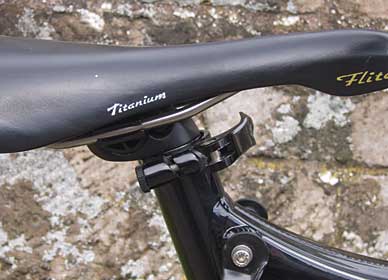 The
standard equipment seems
quite adequate, though I replaced the
saddle and pedals with my own preferences before taking delivery. The
seat post is marked with figures which help to set it back to the
required height after unfolding the bike, and the saddle mounting
allows the angle and reach to be adjusted quite easily - a standard
micro-adjust with a single allen-headed fixing bolt. If you take the
saddle off, rotate the seat pillar through 180 degrees and refit the
saddle, you can extend the reach adjustment somewhat, though in the
longer-reach position this increases the overall folded size of the
bike quite significantly.
The
standard equipment seems
quite adequate, though I replaced the
saddle and pedals with my own preferences before taking delivery. The
seat post is marked with figures which help to set it back to the
required height after unfolding the bike, and the saddle mounting
allows the angle and reach to be adjusted quite easily - a standard
micro-adjust with a single allen-headed fixing bolt. If you take the
saddle off, rotate the seat pillar through 180 degrees and refit the
saddle, you can extend the reach adjustment somewhat, though in the
longer-reach position this increases the overall folded size of the
bike quite significantly.
Turning
the seat post through 180 degrees allows it to be positioned further
back, giving a longer overall reach - which suits me better. However,
it increases the overall folded sized (see also the photograph in
section 10).
The handlebars have a very slight bend towards the rider, but provide no means of adjusting reach - a normal stem is not used, so the only options are the 'standard' stem or the 'Comfort' stem. The former used to give a rather stretched riding position (for most people), and originally it was not adjustable for height, whereas the Comfort stem errs in the opposite direction - a slightly squashed riding position and not possible to get the bars low. I get the impression that the Comfort stem is the more popular now, and there is no longer an extra charge for this if it is bought with the bike, while I believe the standard stem is now adjustable for height. My previous Reds had the standard stem, but this time I opted for the Comfort stem as perhaps being more suitable as I get older. That said, the reach is definitely too short for me (the standard was verging on too long, even with the saddle fully forward). I eased this on the Touring by reversing the seat pillar, giving another 2 or 3 cm reach. However, the height adjustment is limited to 4 click-stop positions, even the lowest of which was much higher than I would like (bars well above seat height). I have worked around this, but I had better not explain how!
Flat bars have the drawback of not allowing any change in hand/arm/riding position, and this can become tiring on longer rides. As usual with such bars, I fitted some small bar-end extensions.
One of the most tiresome omissions on this bike is bottle bosses. Even if you don't want to fit a bottle cage, such mountings can be useful for other things, such as a mini-pump (no pump is supplied with the bike, and I'm not keen on the optional one which is available which fits inside the seat post). I managed to fit a Decathlon cage mount on the steerer tube - it uses integral strong rubber straps to fix it - and I use this for a bottle cage, while the mini-pump has to go in the bag.
For use in the UK, mudguards are really an essential, but they are an extra on the Birdy. The mounting of the front mudguard on the current models is much improved over earlier ones, as the forks now incorporate a mounting for struts at the back/bottom of the mudguard, which overcomes the alarming waggling of the mudguard as you ride. At the rear the substantial mudguard struts double as side supports for panniers.
You can buy a stand for the Birdy, but this attaches around the rear axle and nut/quick release. I had one on my first Birdy, but I was seriously concerned about the stresses it would impose on the rather thin axle supports, so I took it off. The mounting method remains the same (I think), but the axle mountings were made more substantial some time ago. Nevertheless I am still not feel keen on mounting a stand on this bike.
A number of other accessories are listed, including lights (I just use normal LED products) and a pump which stows inside the seat tube (I bought one for my first Birdy, but found it rattled, got dirty and was awkward to reach, and being of the original old-fashioned design with a flexible hose, it was very ineffective; I carry a standard mini-pump instead now, but it is extremely annoying that there is nowhere to mount it on the bike, as there are no bottle cage bosses).
Carriers, luggage and carry bags are covered in the next section.
When the Birdy was first introduced, there was very little provision for carrying luggage - there was a small bag which could be hung under the main tube, but which interferred with folding if you put much in it, and was fiddly to fit and remove (I think it is still available), and there was a very small rack for mounting immediately over the rear wheel on the unsuspended part of the bike, and too small to allow the use of normal panniers (or indeed many rack-top bags). Unfortunately there was really no other way luggage could be caried apart from a large saddlebag (which with a Quick-Release mounting was not a bad solution, but limited in capacity), or a large rucksack balanced on the small rear rack and leaning against the seat pillar (some people seem to have managed with this, but really not a very good solution). Later a rather basic slightly larger rack was produced, which hung from a wire on the saddle, and then a modified front fork became available which could be used with a proprietary rack to take standard small panniers. With well balanced loads and not too much weight, this worked quite well, and with a large rear saddlebag and small rear rack gave reasonable capacity. Now on all models except the Red (which uses the old frame at present), the hinged rack that first appeared for the Birdy Grey is now available. On the plus side, this is sturdy, folds as the bike folds, and also has the considerable advantage that it helps to support the bike upright when the bike is folded. The down side is that it is moderately heavy, not particularly cheap, and the diameter of the main support tubes is unusually big, so that many makes of pannier cannot be fitted (I had to buy a new set of Ortlieb ones, even though I had a perfectly good set of Karrimor panniers). On a technical point, one might also question a rack mounting which has part of the mounting on the unsuspended rear forks and part on the suspended frame, so that as the suspension moves, the rack must pivot between the two (I haven't noticed any negative effects of this, but it is not a desirable feature). Still, I think it can be said that the original criticisms from some people, myself included, levelled at luggage carrying capability are now irrelevant, and the Birdy can be ranked as at least good in this respect, and indeed better than most folders.
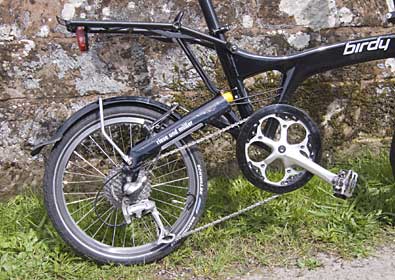 The
rear rack folds down
as the bike is folded. It is quite heavy (0.85Kg or around 2 pounds),
and the large diameter tubes mean that most types of pannier cannot be
fitted as the clips will not go over the tubes. Ortlieb panniers will
fit. Normally I use a Carradice Prima rack top bag, which is
particularly light, but even so the weight of rear rack and bag is all
but 3 pounds, even with nothing in the bag. Note the very robust
mudguard stays, which double as side supports for panniers. The carrier
is rated for up to 15Kg, around 33 lbs.
The
rear rack folds down
as the bike is folded. It is quite heavy (0.85Kg or around 2 pounds),
and the large diameter tubes mean that most types of pannier cannot be
fitted as the clips will not go over the tubes. Ortlieb panniers will
fit. Normally I use a Carradice Prima rack top bag, which is
particularly light, but even so the weight of rear rack and bag is all
but 3 pounds, even with nothing in the bag. Note the very robust
mudguard stays, which double as side supports for panniers. The carrier
is rated for up to 15Kg, around 33 lbs.
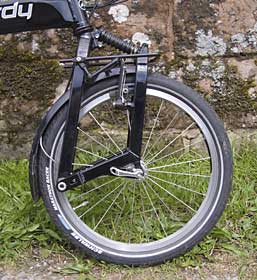 The
front rack is light (180 gms or 6 oz) and unobtrusive - it pivots up to
allow the front wheel to be folded
under. Missing in this photograph is the retaining plate which fits
under the QR skewer to provide lateral support for a front pannier. One
reason I leave this off unless I actually have panniers fitted is that
the front rack fitting instructions
refer to the importance of using a longer skewer when these plates are
fitted, but my front carrier came without such a skewer. The front
carrier is rated for 10Kg, around 22 lbs.
The
front rack is light (180 gms or 6 oz) and unobtrusive - it pivots up to
allow the front wheel to be folded
under. Missing in this photograph is the retaining plate which fits
under the QR skewer to provide lateral support for a front pannier. One
reason I leave this off unless I actually have panniers fitted is that
the front rack fitting instructions
refer to the importance of using a longer skewer when these plates are
fitted, but my front carrier came without such a skewer. The front
carrier is rated for 10Kg, around 22 lbs.
When folded the Birdy is quite compact - certainly larger than a folded Brompton, but at least a shade smaller than most other compact folders, and a lot smaller than some. Before you can start folding, you will need to remove any luggage, and unless you have a very effective quick-release system, this can be quite tedious. Yes, it's the same with almost all folders other than the Brompton, but it is a significant factor in real-life folding time. Then you have to make sure that the bike is in top gear (if it is a derailleur geared model), and in many cases it will be a nuisance when it comes to unfolding and riding off that the bike is in top gear. Next the pedals must be in the right position (left hand pedal at the bottom, lining up with the seat tube). Now you can start on the real folding operation, which involves releasing the handlebar stem QR and adjusting the handlebars (to minimum height if you have them raised - a step I don't need), turning the front wheel slightly to the left (an important step which it is easy to forget!), fold up the front carrier, if fitted, release the suspension catch on the front wheel and swing the wheel back until the tyre is held in place by a bolt projecting from the forks (a change to a narrower or wider tyre will require repositioning of this bolt), release the rear triangle catch and swing the rear triangle under the bike as far as it will go, now and only now turn the front wheel back towards the straight ahead position, lower the saddle, and release the steerer lever and swing the handlebar assembly down. You can see it on the Birdy section of the r&m web site, though I think it looks a bit easier there than it is in practice. Unfolding is the reverse process, except that unfortunately on the new models with the cables running in the frame tubes, when I unfold the cables to the gears at the back do not slide inside the tube of their own accord, but form a nastly loop - if I don't push them back inside the tubes, they will get caught in the crank and pedal when I start riding. Even if the cables don't caught in this way, it must create additional wear and tear on the cables, particularly the outers, always a problem with folders. On the older machines with external cables, this was not an issue. Since the cables are inside the frame tubes, replacement will also be much more awkward. Note that other owners of Birdys with the new frame tell me that they do not have this problem, so perhaps it is unique to mine. Since the cables are inaccessible inside the frame tube, there is little that can be done to find out why it happens on my bike.
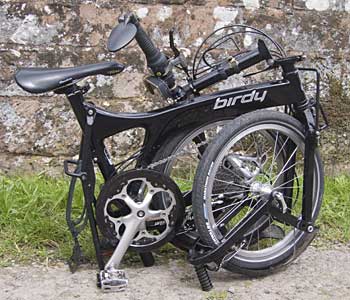
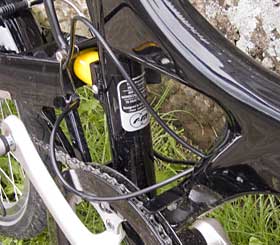
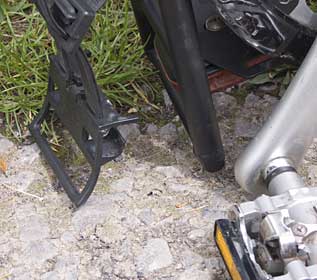
Above: When folded, the Birdy is quite compact, though with the seat pillar reversed to give a comfortable reach with the 'Comfort' stem, the saddle projects quite a long way at the back, and increases the total package size considerably. The folding rack allows the bike to stand securely on its own when folded. The centre picture shows what happens to the gear cables when I unfold the bike - rather than allowing this to happen and then pushing them back into the frame, it is better to push them into the frame when unfolding, which will reduce wear and tear on the cables, if not the owner. Other owners of Birdys with the new frame tell me they do not have this problem. On the right, another minor annoyance is that the elastic strap on the rear rack is released when the folded bike is standing on it - probably the best solution is to discard it completely if, like me, you use a rear bag.
My older Birdys did not have the latest rear carrier (not only was it not available, but it cannot be retro-fitted to older bikes), and when folded they really needed to be leant against something or they would fall over. With the optional folding rear rack, the folded bike now stands very nicely on its own - a very useful improvement. Like a lot of other folders, to move the folded Birdy you needed to lift it, which is reasonably easy by holding the main frame. Although the bike is nominally not particularly heavy, adding mudguards, carriers etc does increase the weight, though it is still reasonably easy to carry. Apparently the latest models have a carrier to which a small jockey wheel can be attached, and with a similar wheel attached to the mudguard strut (assuming you have mudguards) it is possible to drag the bike along. Although I had seen this at the Cycle Show in 2006, it was not available when I bought my Birdy a couple of months later, and I'm not sure if it can be retrofitted to my machine (it is regrettable that a large proportion of the useful improvements which have been made to Birdys over the years cannot be retrofitted to earlier models, at least not without replacing major items). If you regularly fold the machine and need to move it along station platforms this additional accessory could well be useful, especially if you find carrying the bike difficult. Not having this accessory I'm not sure how well it works in practice, especially on rough surfaces.
There are a number of options for bagging the bike - usually I find it is not necessary to do this, but I do carry a light cover which can be dropped over the bike to conceal it if necessary. This actually dates back to my first Birdy, and was something that A to B could supply at that time, but it is no longer available. A case is also available, which might be useful for air travel (except how do you get it to the airport, and what do you do with it when you arrive?).
On the road, or light off-road riding, the Birdy feels quite responsive and comfortable. While the brakes are somewhat disappointing for V's (quite a lot of pull is required, and even then they do not give any real bite), they are quite adequate. Although the ride is quite comfortable, I have found the riding position less than ideal for me - I'm very short, especially in the leg. With the standard stem on my previous Birdys I needed the saddle fully forward, and was still on the border of being too stretched; bar height on these old machines was about right. With the Comfort stem I originally felt much too close to the bars, even with the saddle right back, although reversing the seatpost has brought this to a more comfortable position. Even with the handlebars at their lowest position as determined by the interlocking click stop, they were much too high for me. I also had problems finding a comfortable saddle due to the less than ideal riding position - the saddles I used with minimum problems on various other bikes were not at all comfortable on the Birdy due to the riding position. Of course other riders may find that the position suits them perfectly, and is better than anything else - it's all down to the individual. Since managing to set the bars lower, I've been much more comfortable, and one of my Flite Titanium saddles no longer causes any discomfort either.
When I first rode the Touring I found it commendably free of rattles, a huge improvement over the earlier models I had, which always rattled horribly. One of the improvements seems to be down to the routing of the cables to the back of the bike through the frame - the cables used to rattle against the frame, and it never seemed possible to eliminate this. As mentioned in section 9, the routing of the cables through the frame tubes does have a down side though, and apart from the cable requiring to be pushed back into position when unfolding on my bike, it is likely to result in damage to the cable, and replacement of cable outers will be a far more difficult operation. Unfortunately, more recently a pronounced rattling has become evident when coasting on even slightly rough surfaces. It sounds as though it is the rear hub, which brings back memories of old Sturmey-Archer hub gears, which used to sound like a bag of old nails in these conditions. I never noticed this problem on the Sachs 3x7 systems.
I have used the Birdy Touring for most sorts of travel - some light shopping trips, a number of train-assisted commutes, train assisted travel to moderate day rides, longer day rides, and a train journey to Scotland followed by some moderate riding, fully loaded with large Ortlieb rear panniers, clothes etc for 1 week, a fair sized camera outfit including a tripod, laptop computer, external hard drives for backup, but not the kitchen sink on this occasion. It has handled all of these rides, including regular riding on stretches of reasonable (but not tarmac) canal towpath, very well. In most respects the specification seems just about right, especially now I have a softer yellow suspension elastomer fitted. Reversing the seat pillar and lowering the handlebars more than intended was necessary for me to achieve a comfortable riding position, and the gearing was too high for my taste.
Normally the easy way to lower the overall gearing would be to fit a smaller chainring, but the plates and bracket which help to keep the chain in place when the bike is folded make this a difficult solution. In the last few days I've solved it by replacing the original 11-30 8-speed cassette with a 12-32 8-speed - I don't think these are available any longer, and the version I bought was expensive, but it now gives me a more suitable range of 22 - 105 inches; actually I would not mind being 5-10% lower still, but this is a worthwhile improvement for me. I have previous experience of combined hub/derailleur gear systems, and I have to say that I am not a great fan. They do give a wide range of gears, and are especially suited to small wheeled machines (which otherwise need rather large chainrings to achieve high top gears). They also give some options for changing gear on the hub when stationary. But I feel that rather than getting the benefits of both a hub and derailleur system, you actually suffer more of the drawbacks of both - ie dirt and damage affecting the derailleur, weight and efficiency drawbacks of a hub. However, tre is no multiple chainring alternative production Birdy available, and the Rohloff Birdy is hugely expensive, and has weight and efficiency issues, so for my purposes the 3x8 system was the best option.
I find the Schwalbe Marathon Racer tyres suit my requirements well -
not as free running as the Stelvios, but much less susceptible to
punctures, cuts etc, and the width, tread and lower pressure give a
more comfortable and secure ride on less good surfaces.
When I bought the bike it was fitted with a red (medium hardness) suspension elastomer for the rear suspension, and the supplier was out of stock of the softer, yellow elastomer. On my older Birdys I found the softer elastomer suited my riding style and weight much better, and although I have regrettably put on some weight, I was glad when I was finally able to get the yellow elastomer and fit it, confirming that it is more suitable for me. Overall the suspension works pretty well - it certainly takes the sting out of riding on rougher stretches of normal roads, or off-road. While it is not as effective as a full-travel suspension system on a mountain bike, it is a light, no maintenance system which is very effective. For light off-road riding, such as canal towpaths, cycle tracks and some forest roads, I find the suspension and the general behaviour of the Birdy are excellent, and I am at least as happy on it in these conditions as on a dedicated mountain bike.
The one area in which I have been distincly disappointed is the sensitivity of the front end. My recollection of my previous Birdys is that they both were a bit twitchy, but more particularly they both had some tendency to shimmy - develop a wobble in the steering at higher speeds (especially fast descents), or even if one hand was taken off the handlebars to signal at lower speed. While noticeable on the older bikes, it's my impression that this particular Touring is distinctly worse in this respect, to the extent that giving hand signals is quite a worrying experience, and descents cannot be enjoyed as they should be. There is no obvious slackness in the steering or front suspension, nor any other adjustment that needs making. It must be said that some Birdy owners don't seem to have this problem at all, and some owners of the new machines say they are better than the old ones, but I'm certainly not the only person to notice shimmy with Birdys. Perhaps it is just me, but I don't have this problem with most other bikes, regardless of wheel size (though I have also ridden other makes which exhibit the same issues to some degree).
I still don't find the process of folding and unfolding is as simple and convenient as some other folders. This may in part be a question of the size and strength of the rider - some parts of the fold would be easier if I were taller and had longer arms (I feel a quotation from The Hitch Hikers Guide to the Galaxy coming on!). I also miss the wonderful quick-release front luggage of the Brompton - fiddling around removing and fitting bags on a folder can take as long as, or more than, the time to fold the bike! I suppose a partial solution would be to revert to using the Carradice SQR bag, but to do this incurs an increase in folded height (you can't fully lower the seat post) and would mean removing the rear rack if I was not to suffer a weight penalty, which in turn gives less versatility in choosing the type of luggage to carry and means the bike would not stand up well when folded. When folded, though, the Birdy is pretty compact, and it can be picked up and carried without the need for any securing straps - it doesn't tend to unfold itself.
A point of clarification - when referring to quick fitting and removal of the bags above I was thinking in terms of a smaller and lighter bag used for day trips, such as a rack-top bag. If panniers are being used, the Ortliebs clip on and off quite quickly, but they are rather bulky and heavy for use on short trips.
Since the original report, I have used the Birdy for a 100Km Brevet Populaire in very wet weather conditions. Generally I'd prefer a rather lighter bike for this kind of ride, though both my previous Birdys were used once each for similar rides. I was just about the slowest rider (it's not a race though), but I always am, whatever I ride, and the Birdy was fine for this kind of ride. I was glad of the lowered gearing a couple of times, and the lowered bars also helped in allowing me to be more comfortable.
Choice of a folding cycle is all about horses for courses (and riders) and compromise. All folder design involves compromise (we could say this of just about any product), and so choice is strongly influenced by what it important to the user, and just what the compromises were that the designer made. The Birdy sits pretty centrally in the range of factors to be considered, unlikely to be scored either best or worst in any of the categories on which you might judge a folder. This could be perceived as either a strength or a weakness: if you really want a compact folder for train-assisted commuting involving only short riding distances, there are probably better choices, and also if you want a high-performance bike to cycle long distances, and will only fold occasionally for car travel, again there are better choices. If you want a folder which folds reasonably easily and is quite compact, has a comfortable ride and performs very well in light off-road conditions, can be used for medium-light touring, and can also handle faster day rides, then the Birdy is a very strong contender. In its latest form the Birdy is certainly much improved over the earliest models, even though there are a few niggling minor weaknesses. The Birdy is now a well-engineered machine, well built and with good components. Probably the biggest potential problem is the price - for example, some of the better specified 20-inch wheeled Dahons are quit a bit cheaper, and at least on paper they have comparable specifications.
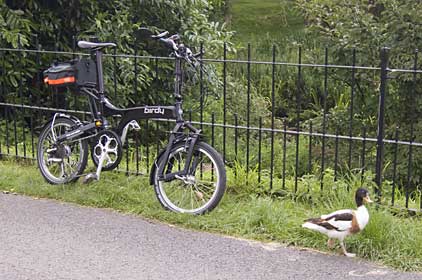
Since the original publication of this report in June 2007, a number of other owners have been kind enough to send in some additional comments, and I'd like to thank them all.
Andreas Rusch:
Gears: I do not consider them too high. I now use a standard 9 speed cog with 11-23, which is perfectly fine for me. I also did Trondheim-Oslo with it (http://www.birdy-freunde.de/reisen/trondheim-oslo.html). Since the Birdy does not include folding pedals I would recommend to go for click pedals. With them efficiency of pedaling is greatly increased.
Wheels and tyres: In my eyes also the best compromise is the Schwalbe Marathon Racer.
Standard Components: My stem is lower than the lowest of the four clicks. I screwed it on with a standard seat post clamp. So far it worked fine. There are several adapters for bottle cages on the market. I fixed one on the stem.
Extras: I use the original stand as provided by R&W. After several years it still supports the bicycle and has not done any damage to the drop outs.
Folding and unfolding: Folding is ok, however folding of a Brompton is much more straightforward. As someone said, the Brompton is the only folding bike that will be folded even when it is not absolutely necessary. Same for me: I also try to avoid folding my Birdy, whereas the Brompton is alway folded and tucked into some tiny corner.
On the road: Quite often I use it as a racing bike. This is really fun. I especially like chasing cyclists on real road racers... I did privately organized training camps on Fuerteventura, Mallorca and mainland Spain. I did not encounter any problems when transporting the Birdy in the dedicated case.
Conclusions:
I would definitely agree
that the Birdy offers the best overall compromise within the folder
world. If you have specific and more one sided requirements, a
different type of folding bike would be better. Last year I could not
resist the temptation and added a Brompton to my stable. Now it is in
regular use for commuting and I do not regret having bought it.
When it comes to conclusions, the basic fundamental question is: Would
you recommend the bicycle to a really good friend? I would recommend
both Birdy and Brompton.
Peter Muenning:
One thing that bothers me about the new bikes is the black anodized seatpost. It looks sharp, but if you fold 3-4 times a day and ride on trails, dirt gets in the steat tube and scratches it very quickly.
Another thing is that the 36 spoke rim is a bit excessive. As is the new (sharper looking but heavier) Alex rim. It's certainly the strongest wheel out there, but who needs a wheel that strong and that heavy? For a 355 wheel, it just adds cost and weight.
So far (knock on wood or touch wood as you say in the UK), I haven't had problems with the cables bunching up. It might be an isolated problem, or it might be due to the fact that your cables are caught above the cable guide (the screw opposite the latch).
My Birdy seems very responsive and fast. I'm not sure why yours feels sluggish. But with Stelvios, it seems subjectively faster than a road bike.
The reach can be adjusted using a standard stem as they do in Australia (http://www.birdy.com.au/).
John Isles:
I
have a monocoque Birdy with a
Rohloff hub. I have not found any problems with the cables during
folding and unfolding. I think this is because, with the Rohloff
models, none of the cables
go through the front of the swingarm, they leave the frame and go
striaght to the rear brake and rear hub. The Rohloff model has other
advantages:
-
The wide gear range and slick
changing of the Rohloff hub itself.
- You can fold the bike in any gear.
- The folded package is a little smaller (no deraileur sticking out).
- You can change chainrings and the strong Rohloff tensioner prevents
the chain from falling off when folding/unfolding.
- no cables snags (as mentioned above).
I also own an older (2000 model) Birdy. The new bike is much quieter and it feels a little stiffer than the old one (probably due to the new stem). The separation of the seatpost clamp and the rear rack is another important improvement, making folding easier.
I feel that the strength of the Birdy design is that it is capable at most things, even though it might not be the best at any one task (I suppose it is best at the one task of being an allrounder).
I use the bike for long tours and fast day rides. Fast day riding is very enjoyable, as I can spend the whole day riding away from home, and then catch the bus/train back in the evening. I can cover more new ground this way, rather than having to retrace my steps riding back in the dark.
I had the same annoyance [with the elastic strap on the rear carrier] but I have come up with a simple solution to this problem. There is another "crossbar" on the rack in front of the rearmost one that can be used to secure the strap. I have cable-tied a piece of silicone tube onto the crossbar to increase it's diameter so the strap will hold. Now the strap stays on when the bike is folded and wheeled around on it's little rollers.
We have had three Birdys now and all of them have exhibited shimmy to some degree when loaded with luggage. [My problems occur with no load, as well as with a load - Ed.]
With a full set of four panniers and tent of the back, the bikes would exhibit a slow-speed ocillation while riding fast downhill. Nothing dangerous, but it can be a bit annoying. We have found that the best way to reduce if not cure this problem is to tighten the pivots for the front swingarm [I had tried this on my Birdy, but it did not seem to solve the problem - Ed]. As the bushings wear, you may find that you cannot tighten them enough (they 'bottom out'). If you undo the large bushing bolt (8mm hex key) on each side of the fork, you will find inside a small washer. Remove the washer and replace the bushing bolt. After removing the washer, you will be able to tighten the bushings further. [Any unauthorised modifications such as this are at your own risk - we are not recommending that anyone should try this -Ed!].
This has in most cases eliminated high speed wobble while carrying luggage.
I have a hunch that the fork/front-swingarm assembly could be stiffer, which might help the handling of the bike.
Despite
these foibles, I still think
that if I could only have one bike, the Birdy all- rounder would have
to be it.
C Thomas:
Hardly a Mountain Bike, but a competent Dirt Bike. On the Chesapeake & Ohio Canal towpath it has no peer. [I certainly find the Birdy excels on this sort of light off-road riding - Ed.]
Birdy SIG | Test reports | Folding Society home page | Riese & Muller home page